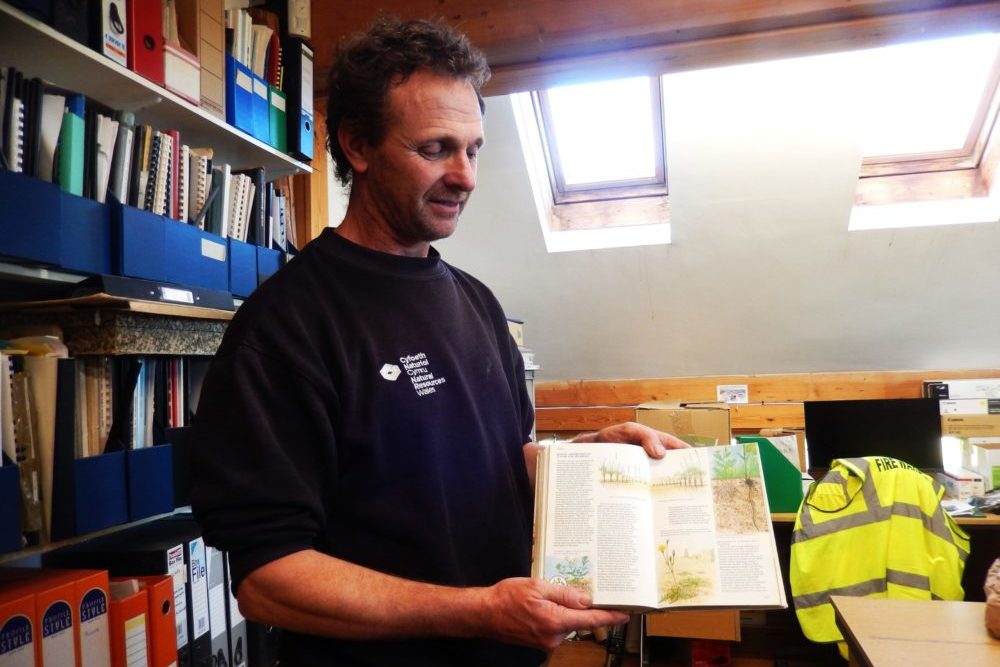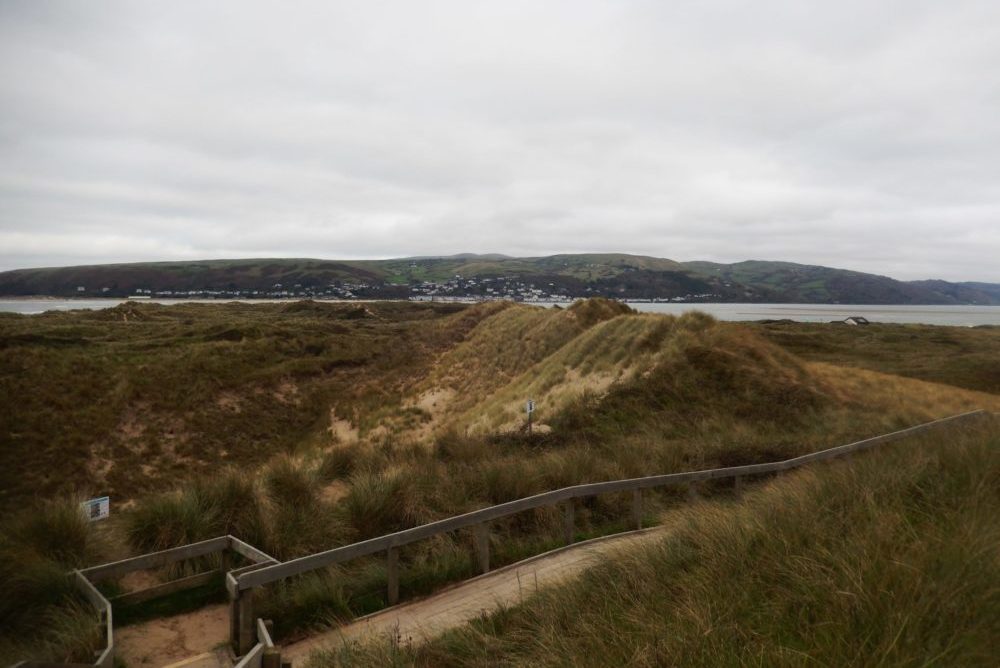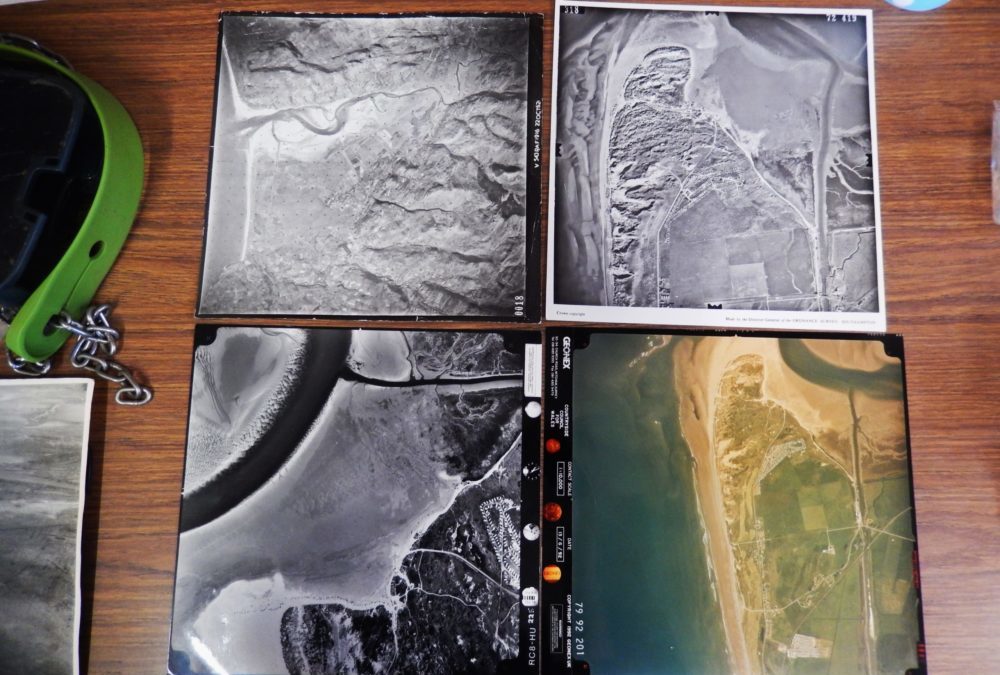Marram; Moresg part four: Justin and Dune Ecology; Ynyslas

Julie Brominicks
The sky is the colour of smoke.
The sound of the sea becomes muffled as I step from the beach through the dunes into Dyfi National Nature Reserve which includes Dyfi Estuary, the raised bog of Cors Fochno, and the Ynyslas dunes.
And now I can feel it prickling my wrists. Marram.
I’ve come to the Natural Resources Wales (NRW) visitor centre in the heart of the reserve, to quiz Justin Lyons about marram. ‘Look’ he says holding up a Collins flower guide.
‘I had this book for my seventeenth birthday. My parents thought I was odd. They were like – ‘is that all he wants?’’ It’s nice to see him laugh. I worked with Justin on an education project here fifteen years ago and know him to be gentle and relaxed.
But we’re in his office upstairs in the visitor centre which is one of three to be closed by NRW in 2025 so now is not a relaxing time.
Although Justin’s job as Senior Officer is secure, and he expects to still use this office, he very much cares about the visitor centre, the staff, and particularly the opportunity it offers the public to engage with nature.

His face when I arrive is creased with stress. He’s worked here 28 years. We go downstairs for vending-machine coffee in the soon-to-be-closed shop. The terrible uprooting is an unhappy topic.
Back upstairs to the book. ‘It also mentions ephemerals’ he says. ‘Shallow-rooted spring ephemerals are worth a mention because their strategy for living in a well-drained environment like the dunes is to get it all done in a season, by the end of May.
They live out the summer as a seed. That’s their strategy. But not marram.’
‘Tell me’ I say, ‘about marram.’ ‘Well marram has got an association with fungi. The fungi massively increases the roots’ ability to absorb water. And then they’ve got rhizomes which can grow a vast amount – we’re talking metres in the space of a year.
‘I guess a rhizome is an underground stem – not a root in terms of its conductive tissue. I think with marram, it’s at its most vigorous in the front of a dune system, in the mobile dunes. Here, that’s at North Point. Being buried actually stimulates it to grow more quickly. Marram has lots of specialisms. There’s a fancy word for marram-type plants that cope with water retention. Xerophytic.’
Justin explains how the dark-green outer surface of the grass most exposed to drying wind and sun has a thick waxy surface and no stomata to exchange water and gases.
All breathing pores and stomata are on the inside glaucous-coloured surface, closed up by the hinge cells so the grass becomes thin and spiky when the weather’s warm and dry to prevent water loss.
I wonder what Justin thinks about harvesting marram for weaving but it’s not an issue he’s yet encountered. The Ynyslas dunes are a fairly narrow system sat on a storm beach and not part of the Sands of Life project.

No excavators are coming to destabilize these dunes and no weavers have asked for permission to harvest marram.
‘I’d have to ask my invertebrate ecologist’ he says. So why is marram important for wildlife? I’d read that grayling caterpillars feed on marram, but not exclusively.
Does anything?
‘It’s fairly unpalatable’ says Justin. ‘It’s really full of silica. We don’t have grayling anymore, they disappeared quite a long time ago. It’s a shame because they’re lovely butterflies.’
He pulls up a record on his computer to confirm what he suspects. ‘A number of insects and fungi have been found feeding on marram but it’s not the preferred food source. Rabbits, sheep and cattle will all graze on it though prefer other plants like red fescue. Small animals and insects do feed on the seeds’ he reads.
‘But in general marram is not the favourite food of anything. But’ he adds, ‘I should imagine it’s really good cover for lots of invertebrates. Somewhere to retreat to that’s safe.’
Both in New Zealand and Cymru, a healthy dune-system is one that is dynamic and mobile with lots of bare sand, allowing specialist plants and animals to colonize and recolonize.
Dunes need to wander at will. In New Zealand without marram.
In Cymru, very much with it. At Ynyslas, the dunes have been gradually growing north into the Dyfi Estuary since the 13th-century at North Point.
‘Some of the new sand is coming from the beach, a lot comes from the sandbars in the estuary when strong winds bring it on low tides.
It’s a natural process’ says Justin, rooting around for aerial photographs that demonstrate the incremental dune-creep.
‘There’s a massive change in 1992. Look. That cut-through where the ringed plover enclosure is now, wasn’t even there. But the Leri Channel used to come out at Ynyslas Turn and would interrupt the longshore drift. Since it’s been re-routed it comes out further up the estuary. Dune evolution is a natural process very much affected by human intervention.’
Ain’t it always the way.

Justin grabs the book he’s had since he was seventeen in the office where he’s worked for 28 years to make me a copy of a diagram.
‘Go away’ he says to the bleeps and flashes as the photocopier does its own thing. ‘Nooooo! Go back!’
The photocopier ignores him.
References
A Handguide to the Wild Flowers of Britain and Northern Europe, by Marjorie Blamey and R.S.R Fitter, Collins, 1990
CABI Digital Library, Ammophila arenaria (marram grass)
Support our Nation today
For the price of a cup of coffee a month you can help us create an independent, not-for-profit, national news service for the people of Wales, by the people of Wales.





The sky is the colour of smoke, the ground a layer of grey powder growing thicker by the minute, my lungs are bursting my breath a flame my hair a torch my soul an ember floating on the wind…
The Last Day of Pompeii…
Or a warning from the future to ‘fire proof’ Cymru…
I see Seascape is getting air time on the Guardian…